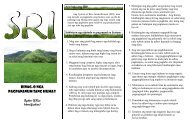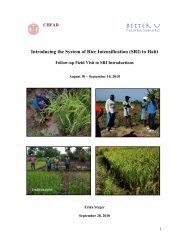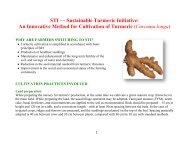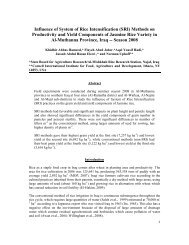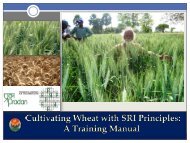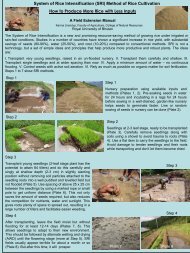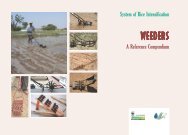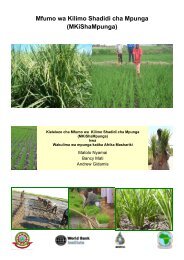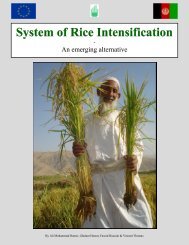EFFECT OF THE SYSTEM OF RICE INTENSIFICATION (SRI) ON ...
EFFECT OF THE SYSTEM OF RICE INTENSIFICATION (SRI) ON ...
EFFECT OF THE SYSTEM OF RICE INTENSIFICATION (SRI) ON ...
You also want an ePaper? Increase the reach of your titles
YUMPU automatically turns print PDFs into web optimized ePapers that Google loves.
growing rice but the Cambodian rains are unpredictable and do not follow any regular pattern, and<br />
may be very delayed causing drought in the middle of the wet season and sometimes flooding<br />
(Nesbitt & Phaloeun, 1997).<br />
The Cambodian climate stretches over two seasons, a wet and a dry season with the wet season<br />
running from May till November and the dry season from mid November till the end of Aprilbeginning<br />
of May (Nesbitt, 1997). The dry season often stretches for less than four months in Prey<br />
Veng province (SCW, 2006). Table 4 illustrates the climate in Phnom Penn which is somewhat very<br />
similar to the climate in Prey Veng.<br />
Prey Veng province has an annual average temperature of 27.23 o C and annual average<br />
precipitation of 1599 mm (SCW, 2006). As a result Prey Veng is one of the driest and warmest<br />
provinces of Cambodia with a growth potential being characterized as a medium concerning rice<br />
production (SCW, 2006).<br />
Table 4. Climatic data from 1995, Phnom Penn. Modified after Nesbitt (1997).<br />
8. Materials and methods<br />
Climate factors 1995 data, Phnom Penn<br />
Relative humidity % 60 – 80<br />
Temperature ( 0 C ) 22 – 40<br />
Day length (hours) 11.5 – 13.2<br />
Evaporation (mm) 120 – 260<br />
30 farmers conducting <strong>SRI</strong> within the ILFARM project in two communes Chorng Om Pil and<br />
Kdeuon Reay Kanhchriech district, Prey Veng province were identified by computing a stratified<br />
random sampling. The project villages located closets to Prey Veng city (where the ILFARM<br />
project is managed from) were chosen and in total were 8 villages chosen. See figure 6 for location<br />
of the eight villages. The number of farmers involved within the project was different from village<br />
to village hence it was not possible to identify the same number in each village. The farmers were<br />
chosen randomly from a list comprising all farmers in the project available at the local CEDAC<br />
office. 30 farmers were chosen due to limitations of funding and time. 30 farmers do as well<br />
represent a fair sample of the total involved number of farmers in the project.<br />
35



